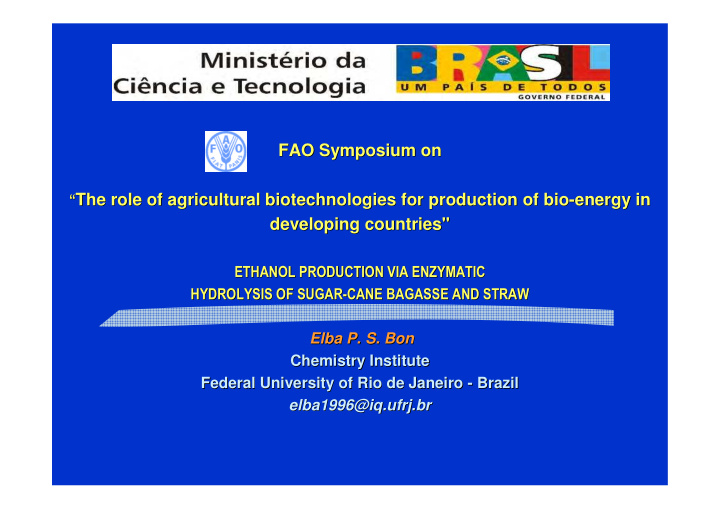



FAO Symposium on FAO Symposium on � The role of agricultural biotechnologies for production of bio � The role of agricultural biotechnologies for production of bio- -energy in energy in developing countries" developing countries" ��������������������������������� ��������������������������������� �������������������� ������������������� ������������������������ ����������������������� Elba P. S. Bon Elba P. S. Bon Chemistry Institute Chemistry Institute Federal University of Rio de Janeiro - - Bra Braz zil il Federal University of Rio de Janeiro elba1996@iq.ufrj.br elba1996@iq.ufrj.br
�������������������� �������������������� • Overview of the Current Brazilian Ethanol Production • Biomass Ethanol • The BIO-ETHANOL Project - Ethanol Production from Sugarcane Biomass via Enzymatic Hydrolysis
�������������������� �������������������� 6 hectares Brasil: 851 x 10 : 851 x 10 6 hectares Brasil ���� ��� �� �! 6 ha : 14,6 10 6 Ceará: 14,6 10 ha Ceará ● ● ● ● 6 ha : 5,7 10 6 Paraíba: 5,7 10 ha Paraíba ���� ���� ���� ���� ���������� ��� 6 ha ● Paraná ● : 20,0 10 6 Paraná: 20,0 10 ha
SUGARCANE / ETHANOL PRODUCTION SUGARCANE / ETHANOL PRODUCTION Brazil has 365 sugar/ethanol producing units from which 240 Brazil has 365 sugar/ethanol producing units from which 240 produce both sugar and ethanol, 109 produce only ethanol produce both sugar and ethanol, 109 produce only ethanol and 15 produce only sugar. and 15 produce only sugar. It is forecast that 41 new distilleries will be built until 2010 It is forecast that 41 new distilleries will be built until 2010 70,000 farmers produced 428 million tons of sugarcane 70,000 farmers produced 428 million tons of sugarcane (2006/2007 harvest) (2006/2007 harvest) The amount of dry bagasse bagasse annually produced by the ethanol annually produced by the ethanol The amount of dry and sugar industry is of 64 million tons and sugar industry is of 64 million tons Refineries made 4 billion gallons of alcohol fuel. Refineries made 4 billion gallons of alcohol fuel. Ethanol production replaces 460 million barrels of oil Ethanol production replaces 460 million barrels of oil
�����" "��������������� ��������������� ����� #��$��� → ����( %���&�� �����'������������ �����' → → →
*+#�%�,�-.�� -.�� �/.�0%12�+.0�,�.*�012* �/.�0%12�+.0�,�.*�012* *+#�%�,� ����( ��')�� ������� ↓ ↓ ↓ ↓ *+#�%�,
������������������ ������� ��&�������� ��&�������� ����������� ��������� → � � �������8����*+#�%�, → → → 6�=7 4.���(�3�����<��'�8���5 #�&���������� → → → � � �������8�� �0�".*-0%*.0*�� → 6�;7 ���*%9:�*���.�12�+0�% ,����� → ��������&����� �'��� �3��� → → → 6��7 ��������� 4.���(�3�������'�-���5
�������������������� �������������������� • Overview of Ethanol Production from Sugar-cane (sucrose) • Biomass Ethanol • The BIO-ETHANOL Project - Ethanol Production from Sugar-cane Biomass
%�������� ������ ��� ���>>>> >>>>3��&��� 3��&���? ? %��
�*,,2,�.��+.2�+2.*��-��0����� �*,,2,�.��+.2�+2.*��-��0����� 1 mm SEM SEM SEM SEM Source: Himmel et.al. in collaboration with the CSM EM Facility (2004)
���� (��� (��� ��������� ��������� ���� Buffer treated corn stover Enzyme treated corn stover ��������������������� ���������������� ������� Note: zone around vascular bundle is eroded compared to native (suggests enzymes leak through pores in bundle)
�*,,�@�,,��+.2�+2.* �*,,�@�,,��+.2�+2.* 1st Challenge: Cell Wall Recalcitrance • Lignocellulose cell walls contain intermeshed carbohydrate and lignin polymers and other minor constituents – The major structural polymers – cellulose, hemicellulose, and lignin – exhibit differential reactivity to thermal, chemical, and biological processing – By natural design, cell wall polysaccharides are more difficult to break down than storage carbohydrates like starch
�*,,�@�,,��+.2�+2.* �*,,�@�,,��+.2�+2.* Cellulose Hemicellulose Lignin
������$��������8���������������� ���� ������$��������8���������������� ���� � ������������� � ���������� ���������� � ��������������������� � ��������������������
*���&��A� A�*�'����������� *�'����������� �� ��*B����������� *B����������� *���&��
�������������������� �������������������� • Overview of the Current Ethanol Production: Sucrose Sugarcane • Biomass Ethanol • The BIOETHANOL Project - Ethanol Production from Sugar-cane Biomass
����� ���� ���C���� ���C����" " �������� �������� ����� ���� �������������� !�"�����#�������������������$���%� ��� &������ ���� ����������� ���� ���� ���$������� ��� ���� ���������� #������� '#������ ���� ����()� ����� ����� �������*� ���� ����������� ��� ���� �������������� #������� ��� ������������� + ��������#����������(����#��������������$��� ��������������������*
����������0������������)�0������������������3������� ����������0������������)�0������������������3������� • 14 Brazilian Universities : UNICAMP/Campinas, USP/Lorena, USP/SãoPaulo, UFRJ/Rio de Janeiro, UENF/Campos, UEM/Maringá, UnB/Brasília, UCS/Caxias do Sul, FURB/Blumenau, UFPE/Recife, UFPB/JoãoPessoa),UFPR/Curitiba,UFG/Goiânia, UFSc/Florianópolis • 2 Research Centers : (IPT/São Paulo and INT/Rio de Janeiro) • Center for Sugarcane Technology Development - CTC /Piracicaba (congregates around 100 sugar and ethanol industries) • CENBIO (National Centre for Biomass Development)/São Paulo Foreign Collaboration • LUND UNIVERSITY - Sweden • The project is open to the establishment of new collaborations.
�����.������ ������ �����.������ ������ • Development of biomass pre-treatment processes for sugar cane bagasse and straw • Raw and pre-treated biomass characterization • Cellulases / xylanases production • Enzymatic hydrolysis • Sugars syrups characterization • Ethanol fermentation ( � � ) • � � sugars and lignin uses • Energy optimisation • Effluents and water
*+#�%�,�-.����0����� *+#�%�,�-.����0����� Bagasse or Straw Pentoses (hemicellulose) Pre-treatment Bio-Refineries/Enzyme Production Lignin Enzyme Enzymatic Hydrolysis (Solid Residue) GLUCOSE Sucrose Ethanol Sucrose Juice or Ethanol Fermentation Yeast Molasses Distillation Stillage *� ����
����&����" "�����&��� �����&��� ����&����
Recommend
More recommend